Navigate your way through the rules, with William Arrenberg, Casey O’Hara, Richard Harryman, Mike Haynes, David Smith, Steve Wade and Malcolm Finney.
PDF
By William Arrenberg and Casey O'Hara
 With effect from 6 April 2013, the
With effect from 6 April 2013, the 
First announced in the 2011 Budget, and subject to a lengthy consultation, the SRT has received a cautious welcome from tax practitioners. The chief aim of the reform is to provide taxpayers with certainty as to their residence status by providing a definition of tax residence which (in the words of the HMRC policy objective) is ‘transparent, objective and simple to use’.
Whilst the test is relatively mechanical in nature, it still requires a detailed assessment of the connections with the UK (the ‘UK ties’) that an individual has, albeit within a clearer and more rigid framework than is currently the case.
Detailed day count records will still need to be kept, as well as information relevant to the existence of UK ties. In short, the amount of information that will need to be gathered and retained under the new regime should not be underestimated. Even with the required information, the tests, particularly in ‘borderline’ cases, remain complex and are likely to be
The flowchart (below) provides an overview of the operations of the SRT and the key principles which apply. That said, each condition involves its own nuances and complexities. The legislation is detailed and should always be reviewed, alongside HMRC guidance and examples, when considering the residence status of an individual. Special rules can apply where an individual dies during a tax year (and these are not dealt with in the flowchart).
Even once the position under the SRT is established, it is important to note that a separate analysis of double tax treaties may be required in order to finally determine an individual’s tax position. Similarly, the position under related rules, such as ‘split year treatment’ and ‘overseas workday relief’ will often need to be considered.
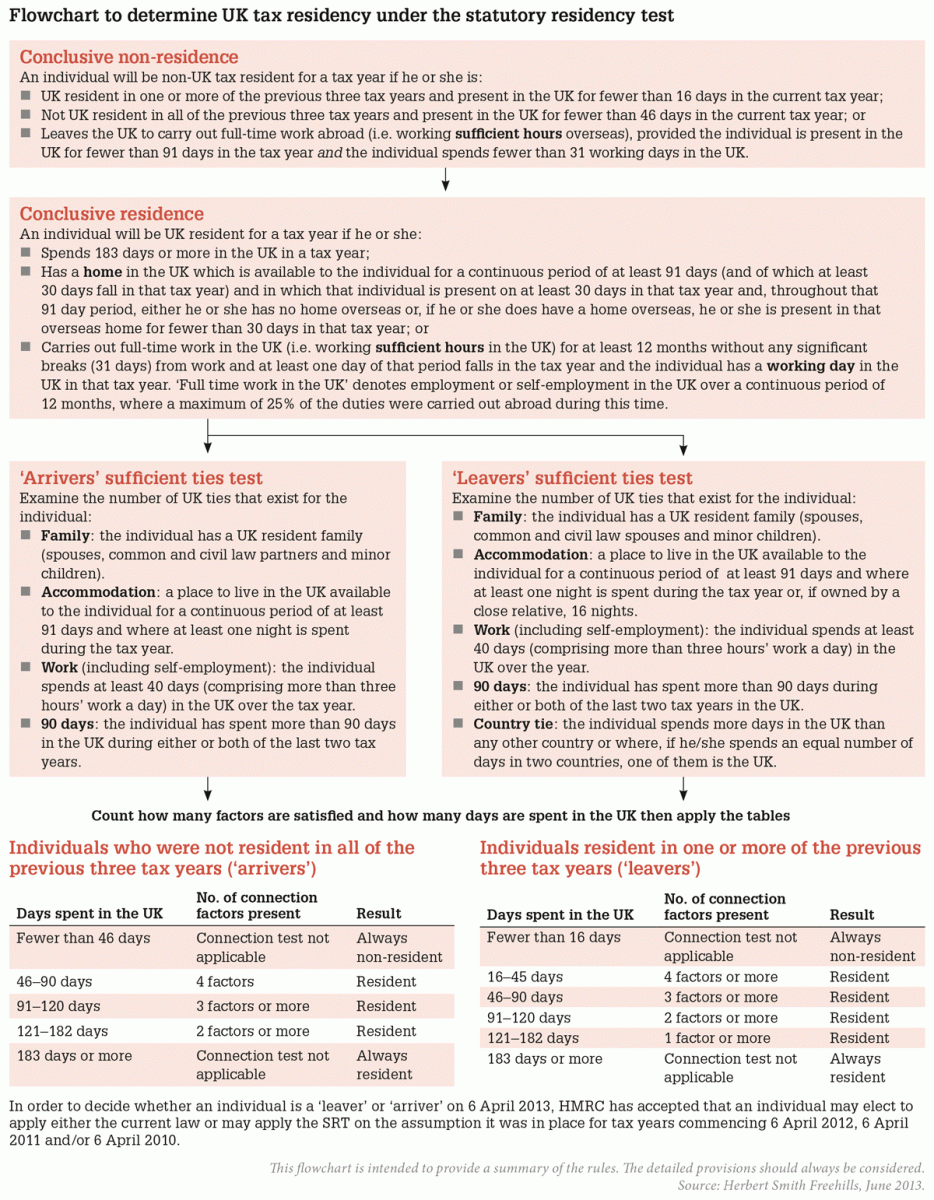
First, apply the ‘conclusive non-residence test’. If that is satisfied, there is no need to go further and the individual will not be UK tax resident.
Otherwise, refer to the ‘conclusive residence test’. If that is satisfied, the person will be UK tax resident.
If neither of the ‘conclusive non-residence’ or ‘conclusive residence’ tests
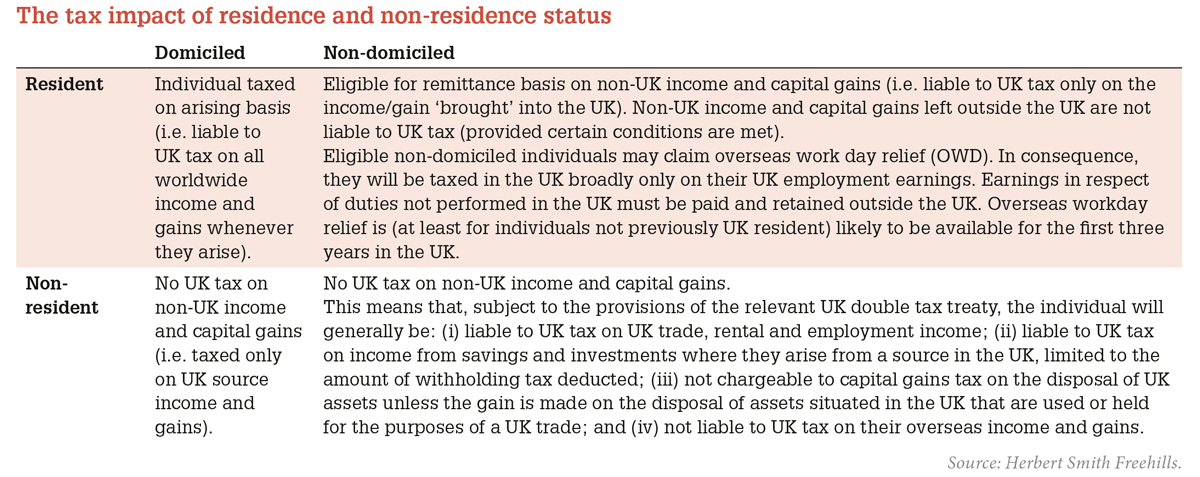
‘Sufficient hours’: an average of 35 hours a week, judged over the course of a year (and in accordance with detailed computational rules).
‘
‘Home’: intended to identify an individual who normally lives in the UK. The individual need not own the home, but there must be a sufficient degree of permanence or stability about the arrangements. It does not include accommodation which is being advertised for sale or let and where the taxpayer lives in another residence. It does not include accommodation in the nature of a holiday home.
‘Accommodation’: available for the taxpayer or family to use (available for a continuous period of at least 91 days in a tax year) as a place of residence and the individual sleeps at that place for at least one night a year (or 16 nights if the accommodation belongs to a close relative of the individual). There is no requirement that the individual holds a legal interest in the accommodation or holds a right to occupy it. The ‘continuous period’ test ignores gaps of fewer than 16 days when the place to live is not available to the taxpayer; a detailed analysis will often be needed.
‘Family’: spouse/partner and minor children (who the taxpayer sees in the UK more than 60 days in a tax year). A day counts as a day that the individual has spent with the child for all or part of the day. A child will not be treated as creating a family connection factor for the individual if they are in full-time education in the UK and spend fewer than 21 days in the UK outside term time.
‘Day spent in the UK’: will require an individual to count a day as spent in the UK when he was in the UK at the end of the day (midnight), save for a situation where the individual: (a) is in the UK at the end of the day because of circumstances beyond his control (up to a maximum of 60 days per tax year); or (b) arrives in the UK as a passenger and leaves the next day and, in the intervening time, engages in activities relevant only to his time in transit through the UK. However, if an individual has three UK ties and is a ‘leaver’, then once he/she has been present in the UK for 30 days (though not at the end of the day), each subsequent day of presence (at any time) counts as a day
‘Work’: includes time spent travelling and on work-related training.
By Richard Harryman and Mike Haynes
 What constitutes a ‘home’ will be straightforward in most instances, but the absence of a clear definition in the legislation could cause some difficulties in borderline cases.
What constitutes a ‘home’ will be straightforward in most instances, but the absence of a clear definition in the legislation could cause some difficulties in borderline cases.
Back in the heady days of 1983, Paul Young famously told us that ‘wherever I lay my hat, that’s my home.’ Thirty years on, the introduction of the statutory residence test from 6 April means defining one’s home is slightly less black or white than where one lays down one’s Akubra.
The term ‘home’ is used throughout the SRT and is an important part of determining tax residence, and when it is possible to split a tax year of residence into a UK part and an overseas part. Determining the existence of a home will be straightforward in most instances, but for more complicated cases there remains uncertainty in determining when accommodation becomes more than just a place to sleep and becomes a ‘home’.
Finance Bill 2013 explains what a home could be and what it is not. However, there is little explanation of what a home actually is, other than indicating that there must be sufficient ‘permanence’ and ‘stability’. HMRC guidance does not take us much further, referencing what a ‘reasonable onlooker with knowledge of the material facts would regard as that person’s home’.
Defining a ‘home’: As a starting point, we can narrow the concept down by explaining what we know a home cannot be, and what factors are irrelevant. We know that accommodation is not a home if it is:
We also know that the nature of the accommodation is largely irrelevant. Canal boats, caravans and sheds could all potentially be a home. Whether the property is owned does not determine whether it is a home, but that ownership may form part of the wider circumstances considered when reaching a conclusion.
For example, consider Mary, who lives in a rented flat with her partner and children. She also owns a cottage in Norfolk which is used for family holidays. The legal title to the flat and holiday home is irrelevant; the flat will be
A home can also exist even where the individual is not there continuously. This principle extends to the situation where the home becomes temporarily unavailable (for example through flood damage).
Continuing our example, if Mary moves to France for three months but her family remain in the flat, she will continue to have
‘Accommodation’ vs ‘home’ – an objective test?: The factors turning ‘accommodation’ into a ‘home’ are not considered in the legislation or guidance. It is likely that a personal, subjective connection between the individual and accommodation creates the stability/permanence which would lead a reasonable onlooker to regard it as being
Prove it!: HMRC’s guidance suggests a range of evidence that individuals can retain to help establish the facts of each case, some of which touch on the individual’s ‘lifestyle’ in a location, such as club memberships. Such documents will be more helpful in demonstrating that
Although the vast majority of situations will be straightforward, the inherently subjective nature of the term ‘home’ could lead to some difficult cases being taken to the tribunal. This may
By David Smith
 Under the new rules, split year treatment will apply in eight ‘cases’. The focus now is on meeting prescriptive, objective conditions, rather than the more subjective concepts that were previously used.
Under the new rules, split year treatment will apply in eight ‘cases’. The focus now is on meeting prescriptive, objective conditions, rather than the more subjective concepts that were previously used.
Under the pre-6 April 2013 rules, once an individual was treated as UK resident in a tax year, he was treated as UK resident for the whole of that tax year, regardless of when during that year he came
This approach, of treating an individual as UK resident for the whole of a tax year, but allowing it to be split into two parts in certain circumstances, has been replicated under the SRT rules, with the various split year
When does split year treatment apply?: As a preliminary point, it is worth noting that split year treatment only applies to individuals in their capacity as individuals. It does not apply to individuals acting as personal representatives and only applies in a limited form where an individual is acting as a trustee.
There are eight circumstances (or ‘cases’) where split year treatment will apply. These break down into three cases which cover situations where an individual leaves the UK part-way through a tax year and five cases where an individual arrives in the UK part-way through a year. Where an individual’s circumstances fall within more than one of these cases, perhaps unsurprisingly, the case in which the overseas part of the year is the shortest takes priority.
The three cases which cover departures from the UK apply, in very broad terms, where an individual starts full-time work overseas; where an individual accompanies their partner who is starting full-time work overseas; and where an individual leaves the UK to live overseas and ceases to have
All of the cases have one common condition, which is that the individual must be UK resident (under the SRT) for the tax year in which split year treatment is sought. However, other than this, each of the cases
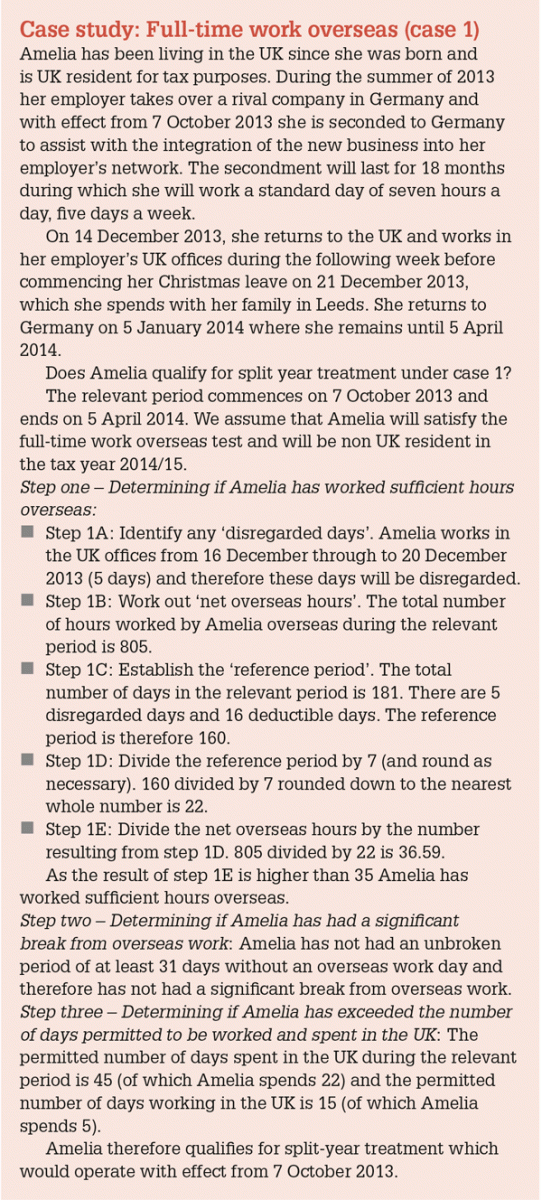
Under case 1, in order to benefit from split year treatment for tax year X, a person (P) must:
A ‘relevant period’ for these purposes is one which begins on a day on which P does more than three hours of work overseas and ends on the last day of year X.
To determine whether the ‘overseas work criteria’ has been satisfied, there are a number of steps which need to be considered.
Step 1: Determining if P has worked sufficient hours overseas: The purpose of this step is to determine whether the individual is working full-time overseas during the relevant period. Unlike under ESC A11, where the concept of full-time work was (subject to the application of Revenue Interpretation 40) largely subjective and
To establish whether P has worked sufficient hours overseas there are a number of additional steps to work through:
If the answer at Step 1E is 35 or more, P will have worked sufficient hours overseas.
Step 2: Determining if P has had a significant break from overseas work: P will have had a significant break from overseas work, and as a result will fail the overseas work criteria, if P has an unbroken period of at least 31 days without an overseas
Step 3: Determining if P has exceeded the number of days permitted to be worked and spent in the UK: During the relevant period P must not exceed the maximum number of days to be worked and spent in the UK, being 30 (worked) and 90 (spent) as reduced proportionately by reference to the whole number of months in the part of year X before the relevant period (see the table below).
Summary: As will be clear, in order to demonstrate that the above conditions have been satisfied (and this applies across all of the cases, not just case 1), it is imperative that P closely monitors his or her compliance with the various conditions and keeps detailed records evidencing this compliance. In particular, in the context of case 1, evidence should be retained regarding the time and dates spent both in the UK and overseas, the nature of activities undertaken and, perhaps most importantly, the number of hours spent working both in the UK and overseas. HMRC guidance includes a non-exhaustive list of the types of information and records that P should keep in this context, which includes details of breaks from working (for example, between jobs or on annual, sick or parental leave) and copies of any work diaries, calendars or timesheets to demonstrate the nature and duration of work activities.
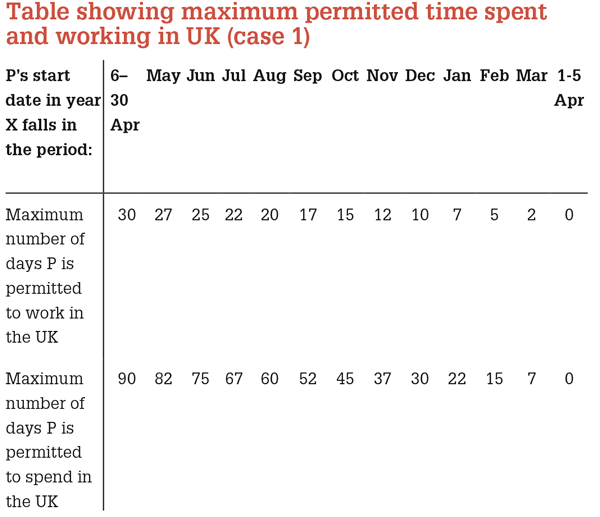
By Steve Wade
 There are a number of practical considerations for executives, not least extensive record keeping.
There are a number of practical considerations for executives, not least extensive record keeping.
It has long been HMRC’s practice to accept that employees assigned abroad could break UK residence by being regarded as ‘working full-time abroad’ (WFTA) without the need to sever all their ties with the UK. Unfortunately, exactly when an employee passed this test was never completely defined. The SRT maintains this route to non-residence but with substantial differences in the detail. An individual must have ‘sufficient hours’ working overseas and be present in the UK for fewer than 91 days in the tax year, with fewer than 31 days spent working in the UK (FB 2013 Sch 43 para 14(1)).
Differences from the previous practice include:
One of the automatic tests for UK residence depends on whether the individual works sufficient hours in the UK (Sch 43 para 9(1)). This is assessed over a 365-day period where over 75% of the days worked are days worked in the UK. For this purpose, a work day is a day of more than three hours’ work. Two significant changes from the version published in the draft Finance Bill have been made to this test, namely:
Under previous rules, an individual was either resident or non-resident in the UK for the whole tax year. However, under
As part of the SRT, the split years are incorporated into statute with eight cases when the year is split into
These will include the following:
Resident but not ordinarily resident employees were previously taxable on their general earnings for UK duties, whether or not these earnings were paid in the UK. If such employees elected for the remittance basis, their general earnings for non-UK duties were only liable to UK taxation if they were remitted to the UK. The unremitted earnings not being taxed in the UK is commonly described as ‘overseas workdays relief’ (OWR). OWR will continue under the proposed SRT, despite the proposal to abolish ordinary residence for most tax purposes.
From 6 April 2013, resident employees will be able to claim relief for a particular tax year if they are non-UK domiciled, claim the remittance basis, and meet one of the following conditions:
Employees who were resident for 2012/13 but not ordinarily resident at 5 April 2013 may be able to continue to claim relief under transitional provisions if they meet certain conditions, including remaining resident but not ordinarily resident under the pre-SRT 6 April regime (FB 2013 Sch 44 para 26 (1)).
The amount of
If an employee qualifies for OWR, claims the remittance basis and has earnings for
HMRC has recognised the difficulties that arose with the original draft legislation on nominating an account. The revised legislation in the Finance Bill (Sch 6 para 6 inserting s 809RB(8)) allows employees to nominate an account up to 31 January following the tax year in which sums are paid into the account, with the nomination being made in the white space of a tax return.
It is possible to nominate joint accounts, but if the account contains the employment income of two individuals, neither can nominate the account.
When an existing account is nominated, the cash balance in this account must be below £10 immediately before the ‘qualifying date’. The qualifying date is the first date on which general earnings exceeding £10 are paid into the account. The general earnings must relate to the tax year during which the individual qualifies for OWR and has some UK and non-UK duties. The result of this is that the nomination may not be possible unless a new account is opened when the individual arrives in the UK.
Many of the issues that exist under the previous practice will remain issues under this legislation. For example, ensuring sufficient earnings are kept offshore when benefits paid in the UK are considered, maintaining sufficiently robust records to justify any overseas workdays and tracking remittances.
Apart from the transitional provisions, arguments over whether the individual is ordinarily resident or not (at least for tax purposes) and therefore entitled to the relief, will
UK domiciled individuals can no longer qualify for relief and non-domiciled individuals have to have been non-resident for three tax
Care will need to be taken over when the nomination can be made and the contents of the account, particularly when an employee does not have any overseas workdays when they first arrive and when an employee is not considered resident when they first arrive. Employees should where possible ensure they qualify for the simplified mixed fund rules.
There is a perception that the UK often overcomplicates its tax legislation. The legislation on OWR is no exception, having such complicated rules that the legislation needs ‘special mixed fund’ rules to simplify the normal basis of calculation. It is a pity that the opportunity to introduce a simpler relief, that allowed the funds to be brought to the UK for the benefit of the UK economy, wasn’t taken.
By Malcolm Finney
Death complicates matters.
 The residence status (and indeed domicile status) of an individual in the tax year of death is important. Inter alia, it impacts on the:
The residence status (and indeed domicile status) of an individual in the tax year of death is important. Inter alia, it impacts on the:
Specific provisions apply in the tax year of death, namely: the fourth and fifth automatic overseas tests (AOTs) (FB 2013 Sch 43 paras 15 and 16); the fourth automatic UK test (AUKT) (FB 2013 Sch 43 para 10); and the sufficient ties test (STT) (FB 2013 Sch 43 para 20).
Although perhaps not clear from the SRT legislation, other provisions, although of more general application, may also apply in the tax year of death, namely, the third AOT (FB 2013 Sch 43 para 14) and the first, second and third AUKT (FB 2013 Sch 43 paras 7, 8 and 9).
Only the first and second AOTs (FB 2013 Sch 43 paras 12 and 13) have no application to the tax year of death.
Because of the precedence provisions (FB 2013 Sch 43 paras 5 and 17), in practice, the order of consideration of the relevant tests applicable in the tax year of death should be: first, the AOTs; then, if necessary, the AUKTs; and finally, if necessary, the STT.
Individuals are protected from automatic UK residency (i.e. are automatically non-UK resident) in the tax year of death if the fourth, fifth or third AOT is satisfied. Even if none of these three AOTs is satisfied, non-UK residence status may still apply (although not automatically) if none of the AUKTs or STT
Fourth AOT (para 15): The fourth AOT offers protection from UK residency if an individual spends no more than 45 days in the UK (excluding the day of death (para 22)) in the tax year of death and is non-UK resident for the prior two tax years (or non-UK resident for the prior tax year and split year treatment (para 43) applies for the tax year before that under case 1, 2 or 3 (para 15)).

Fifth AOT (para 16): The fifth AOT (formerly, ‘working full-time overseas’, now ‘working sufficient hours overseas’) is more restrictive than the fourth AOT requiring that the individual satisfied the third AOT in the tax year of death (para 16(1)(c)) and also in the previous two tax years (para 16(1)(b)); note para 16(2)).
Third AOT (para 14): Non-UK residency may also be possible under the third AOT. Prima facie, this requires that the individual dies towards the end of the tax year in order to ensure that the ‘working sufficient hours overseas’ requirement (para 14(1)(a)), as measured over the whole of the tax year of death, is satisfied

STT (para 16): The STT aims to catch those individuals with ‘ties’ (i.e. connections; para 17(2)) to the UK who do not satisfy any of the AOTs or AUKTs.
The STT applies to so-called ‘leavers’ or ‘arrivers’, albeit slightly differently (paras 17 and 18). The STT applies by way of a correlation of the number of days spent in the UK with the number of UK ties, although the precise correlation varies according to the date of an individual’s death within the tax year (paras 18, 19 and 20). The later in the tax year an individual dies, the fewer the number of UK ties necessary to precipitate UK residency. Indeed,
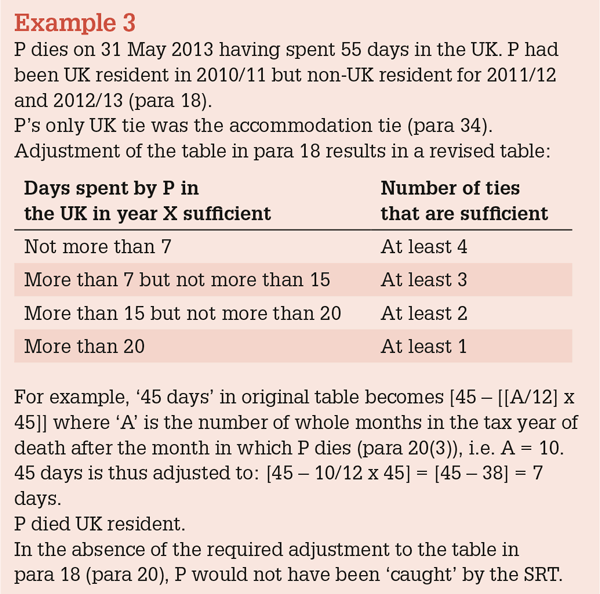
In short, an individual it seems could die non-UK resident in the tax year immediately following a tax year of UK residency if the third AOT could be satisfied.
Otherwise, it is necessary for an individual to be
Navigate your way through the rules, with William Arrenberg, Casey O’Hara, Richard Harryman, Mike Haynes, David Smith, Steve Wade and Malcolm Finney.
PDF
By William Arrenberg and Casey O'Hara
 With effect from 6 April 2013, the
With effect from 6 April 2013, the 
First announced in the 2011 Budget, and subject to a lengthy consultation, the SRT has received a cautious welcome from tax practitioners. The chief aim of the reform is to provide taxpayers with certainty as to their residence status by providing a definition of tax residence which (in the words of the HMRC policy objective) is ‘transparent, objective and simple to use’.
Whilst the test is relatively mechanical in nature, it still requires a detailed assessment of the connections with the UK (the ‘UK ties’) that an individual has, albeit within a clearer and more rigid framework than is currently the case.
Detailed day count records will still need to be kept, as well as information relevant to the existence of UK ties. In short, the amount of information that will need to be gathered and retained under the new regime should not be underestimated. Even with the required information, the tests, particularly in ‘borderline’ cases, remain complex and are likely to be
The flowchart (below) provides an overview of the operations of the SRT and the key principles which apply. That said, each condition involves its own nuances and complexities. The legislation is detailed and should always be reviewed, alongside HMRC guidance and examples, when considering the residence status of an individual. Special rules can apply where an individual dies during a tax year (and these are not dealt with in the flowchart).
Even once the position under the SRT is established, it is important to note that a separate analysis of double tax treaties may be required in order to finally determine an individual’s tax position. Similarly, the position under related rules, such as ‘split year treatment’ and ‘overseas workday relief’ will often need to be considered.

First, apply the ‘conclusive non-residence test’. If that is satisfied, there is no need to go further and the individual will not be UK tax resident.
Otherwise, refer to the ‘conclusive residence test’. If that is satisfied, the person will be UK tax resident.
If neither of the ‘conclusive non-residence’ or ‘conclusive residence’ tests

‘Sufficient hours’: an average of 35 hours a week, judged over the course of a year (and in accordance with detailed computational rules).
‘
‘Home’: intended to identify an individual who normally lives in the UK. The individual need not own the home, but there must be a sufficient degree of permanence or stability about the arrangements. It does not include accommodation which is being advertised for sale or let and where the taxpayer lives in another residence. It does not include accommodation in the nature of a holiday home.
‘Accommodation’: available for the taxpayer or family to use (available for a continuous period of at least 91 days in a tax year) as a place of residence and the individual sleeps at that place for at least one night a year (or 16 nights if the accommodation belongs to a close relative of the individual). There is no requirement that the individual holds a legal interest in the accommodation or holds a right to occupy it. The ‘continuous period’ test ignores gaps of fewer than 16 days when the place to live is not available to the taxpayer; a detailed analysis will often be needed.
‘Family’: spouse/partner and minor children (who the taxpayer sees in the UK more than 60 days in a tax year). A day counts as a day that the individual has spent with the child for all or part of the day. A child will not be treated as creating a family connection factor for the individual if they are in full-time education in the UK and spend fewer than 21 days in the UK outside term time.
‘Day spent in the UK’: will require an individual to count a day as spent in the UK when he was in the UK at the end of the day (midnight), save for a situation where the individual: (a) is in the UK at the end of the day because of circumstances beyond his control (up to a maximum of 60 days per tax year); or (b) arrives in the UK as a passenger and leaves the next day and, in the intervening time, engages in activities relevant only to his time in transit through the UK. However, if an individual has three UK ties and is a ‘leaver’, then once he/she has been present in the UK for 30 days (though not at the end of the day), each subsequent day of presence (at any time) counts as a day
‘Work’: includes time spent travelling and on work-related training.
By Richard Harryman and Mike Haynes
 What constitutes a ‘home’ will be straightforward in most instances, but the absence of a clear definition in the legislation could cause some difficulties in borderline cases.
What constitutes a ‘home’ will be straightforward in most instances, but the absence of a clear definition in the legislation could cause some difficulties in borderline cases.
Back in the heady days of 1983, Paul Young famously told us that ‘wherever I lay my hat, that’s my home.’ Thirty years on, the introduction of the statutory residence test from 6 April means defining one’s home is slightly less black or white than where one lays down one’s Akubra.
The term ‘home’ is used throughout the SRT and is an important part of determining tax residence, and when it is possible to split a tax year of residence into a UK part and an overseas part. Determining the existence of a home will be straightforward in most instances, but for more complicated cases there remains uncertainty in determining when accommodation becomes more than just a place to sleep and becomes a ‘home’.
Finance Bill 2013 explains what a home could be and what it is not. However, there is little explanation of what a home actually is, other than indicating that there must be sufficient ‘permanence’ and ‘stability’. HMRC guidance does not take us much further, referencing what a ‘reasonable onlooker with knowledge of the material facts would regard as that person’s home’.
Defining a ‘home’: As a starting point, we can narrow the concept down by explaining what we know a home cannot be, and what factors are irrelevant. We know that accommodation is not a home if it is:
We also know that the nature of the accommodation is largely irrelevant. Canal boats, caravans and sheds could all potentially be a home. Whether the property is owned does not determine whether it is a home, but that ownership may form part of the wider circumstances considered when reaching a conclusion.
For example, consider Mary, who lives in a rented flat with her partner and children. She also owns a cottage in Norfolk which is used for family holidays. The legal title to the flat and holiday home is irrelevant; the flat will be
A home can also exist even where the individual is not there continuously. This principle extends to the situation where the home becomes temporarily unavailable (for example through flood damage).
Continuing our example, if Mary moves to France for three months but her family remain in the flat, she will continue to have
‘Accommodation’ vs ‘home’ – an objective test?: The factors turning ‘accommodation’ into a ‘home’ are not considered in the legislation or guidance. It is likely that a personal, subjective connection between the individual and accommodation creates the stability/permanence which would lead a reasonable onlooker to regard it as being
Prove it!: HMRC’s guidance suggests a range of evidence that individuals can retain to help establish the facts of each case, some of which touch on the individual’s ‘lifestyle’ in a location, such as club memberships. Such documents will be more helpful in demonstrating that
Although the vast majority of situations will be straightforward, the inherently subjective nature of the term ‘home’ could lead to some difficult cases being taken to the tribunal. This may
By David Smith
 Under the new rules, split year treatment will apply in eight ‘cases’. The focus now is on meeting prescriptive, objective conditions, rather than the more subjective concepts that were previously used.
Under the new rules, split year treatment will apply in eight ‘cases’. The focus now is on meeting prescriptive, objective conditions, rather than the more subjective concepts that were previously used.
Under the pre-6 April 2013 rules, once an individual was treated as UK resident in a tax year, he was treated as UK resident for the whole of that tax year, regardless of when during that year he came
This approach, of treating an individual as UK resident for the whole of a tax year, but allowing it to be split into two parts in certain circumstances, has been replicated under the SRT rules, with the various split year
When does split year treatment apply?: As a preliminary point, it is worth noting that split year treatment only applies to individuals in their capacity as individuals. It does not apply to individuals acting as personal representatives and only applies in a limited form where an individual is acting as a trustee.
There are eight circumstances (or ‘cases’) where split year treatment will apply. These break down into three cases which cover situations where an individual leaves the UK part-way through a tax year and five cases where an individual arrives in the UK part-way through a year. Where an individual’s circumstances fall within more than one of these cases, perhaps unsurprisingly, the case in which the overseas part of the year is the shortest takes priority.
The three cases which cover departures from the UK apply, in very broad terms, where an individual starts full-time work overseas; where an individual accompanies their partner who is starting full-time work overseas; and where an individual leaves the UK to live overseas and ceases to have
All of the cases have one common condition, which is that the individual must be UK resident (under the SRT) for the tax year in which split year treatment is sought. However, other than this, each of the cases

Under case 1, in order to benefit from split year treatment for tax year X, a person (P) must:
A ‘relevant period’ for these purposes is one which begins on a day on which P does more than three hours of work overseas and ends on the last day of year X.
To determine whether the ‘overseas work criteria’ has been satisfied, there are a number of steps which need to be considered.
Step 1: Determining if P has worked sufficient hours overseas: The purpose of this step is to determine whether the individual is working full-time overseas during the relevant period. Unlike under ESC A11, where the concept of full-time work was (subject to the application of Revenue Interpretation 40) largely subjective and
To establish whether P has worked sufficient hours overseas there are a number of additional steps to work through:
If the answer at Step 1E is 35 or more, P will have worked sufficient hours overseas.
Step 2: Determining if P has had a significant break from overseas work: P will have had a significant break from overseas work, and as a result will fail the overseas work criteria, if P has an unbroken period of at least 31 days without an overseas
Step 3: Determining if P has exceeded the number of days permitted to be worked and spent in the UK: During the relevant period P must not exceed the maximum number of days to be worked and spent in the UK, being 30 (worked) and 90 (spent) as reduced proportionately by reference to the whole number of months in the part of year X before the relevant period (see the table below).
Summary: As will be clear, in order to demonstrate that the above conditions have been satisfied (and this applies across all of the cases, not just case 1), it is imperative that P closely monitors his or her compliance with the various conditions and keeps detailed records evidencing this compliance. In particular, in the context of case 1, evidence should be retained regarding the time and dates spent both in the UK and overseas, the nature of activities undertaken and, perhaps most importantly, the number of hours spent working both in the UK and overseas. HMRC guidance includes a non-exhaustive list of the types of information and records that P should keep in this context, which includes details of breaks from working (for example, between jobs or on annual, sick or parental leave) and copies of any work diaries, calendars or timesheets to demonstrate the nature and duration of work activities.

By Steve Wade
 There are a number of practical considerations for executives, not least extensive record keeping.
There are a number of practical considerations for executives, not least extensive record keeping.
It has long been HMRC’s practice to accept that employees assigned abroad could break UK residence by being regarded as ‘working full-time abroad’ (WFTA) without the need to sever all their ties with the UK. Unfortunately, exactly when an employee passed this test was never completely defined. The SRT maintains this route to non-residence but with substantial differences in the detail. An individual must have ‘sufficient hours’ working overseas and be present in the UK for fewer than 91 days in the tax year, with fewer than 31 days spent working in the UK (FB 2013 Sch 43 para 14(1)).
Differences from the previous practice include:
One of the automatic tests for UK residence depends on whether the individual works sufficient hours in the UK (Sch 43 para 9(1)). This is assessed over a 365-day period where over 75% of the days worked are days worked in the UK. For this purpose, a work day is a day of more than three hours’ work. Two significant changes from the version published in the draft Finance Bill have been made to this test, namely:
Under previous rules, an individual was either resident or non-resident in the UK for the whole tax year. However, under
As part of the SRT, the split years are incorporated into statute with eight cases when the year is split into
These will include the following:
Resident but not ordinarily resident employees were previously taxable on their general earnings for UK duties, whether or not these earnings were paid in the UK. If such employees elected for the remittance basis, their general earnings for non-UK duties were only liable to UK taxation if they were remitted to the UK. The unremitted earnings not being taxed in the UK is commonly described as ‘overseas workdays relief’ (OWR). OWR will continue under the proposed SRT, despite the proposal to abolish ordinary residence for most tax purposes.
From 6 April 2013, resident employees will be able to claim relief for a particular tax year if they are non-UK domiciled, claim the remittance basis, and meet one of the following conditions:
Employees who were resident for 2012/13 but not ordinarily resident at 5 April 2013 may be able to continue to claim relief under transitional provisions if they meet certain conditions, including remaining resident but not ordinarily resident under the pre-SRT 6 April regime (FB 2013 Sch 44 para 26 (1)).
The amount of
If an employee qualifies for OWR, claims the remittance basis and has earnings for
HMRC has recognised the difficulties that arose with the original draft legislation on nominating an account. The revised legislation in the Finance Bill (Sch 6 para 6 inserting s 809RB(8)) allows employees to nominate an account up to 31 January following the tax year in which sums are paid into the account, with the nomination being made in the white space of a tax return.
It is possible to nominate joint accounts, but if the account contains the employment income of two individuals, neither can nominate the account.
When an existing account is nominated, the cash balance in this account must be below £10 immediately before the ‘qualifying date’. The qualifying date is the first date on which general earnings exceeding £10 are paid into the account. The general earnings must relate to the tax year during which the individual qualifies for OWR and has some UK and non-UK duties. The result of this is that the nomination may not be possible unless a new account is opened when the individual arrives in the UK.
Many of the issues that exist under the previous practice will remain issues under this legislation. For example, ensuring sufficient earnings are kept offshore when benefits paid in the UK are considered, maintaining sufficiently robust records to justify any overseas workdays and tracking remittances.
Apart from the transitional provisions, arguments over whether the individual is ordinarily resident or not (at least for tax purposes) and therefore entitled to the relief, will
UK domiciled individuals can no longer qualify for relief and non-domiciled individuals have to have been non-resident for three tax
Care will need to be taken over when the nomination can be made and the contents of the account, particularly when an employee does not have any overseas workdays when they first arrive and when an employee is not considered resident when they first arrive. Employees should where possible ensure they qualify for the simplified mixed fund rules.
There is a perception that the UK often overcomplicates its tax legislation. The legislation on OWR is no exception, having such complicated rules that the legislation needs ‘special mixed fund’ rules to simplify the normal basis of calculation. It is a pity that the opportunity to introduce a simpler relief, that allowed the funds to be brought to the UK for the benefit of the UK economy, wasn’t taken.
By Malcolm Finney
Death complicates matters.
 The residence status (and indeed domicile status) of an individual in the tax year of death is important. Inter alia, it impacts on the:
The residence status (and indeed domicile status) of an individual in the tax year of death is important. Inter alia, it impacts on the:
Specific provisions apply in the tax year of death, namely: the fourth and fifth automatic overseas tests (AOTs) (FB 2013 Sch 43 paras 15 and 16); the fourth automatic UK test (AUKT) (FB 2013 Sch 43 para 10); and the sufficient ties test (STT) (FB 2013 Sch 43 para 20).
Although perhaps not clear from the SRT legislation, other provisions, although of more general application, may also apply in the tax year of death, namely, the third AOT (FB 2013 Sch 43 para 14) and the first, second and third AUKT (FB 2013 Sch 43 paras 7, 8 and 9).
Only the first and second AOTs (FB 2013 Sch 43 paras 12 and 13) have no application to the tax year of death.
Because of the precedence provisions (FB 2013 Sch 43 paras 5 and 17), in practice, the order of consideration of the relevant tests applicable in the tax year of death should be: first, the AOTs; then, if necessary, the AUKTs; and finally, if necessary, the STT.
Individuals are protected from automatic UK residency (i.e. are automatically non-UK resident) in the tax year of death if the fourth, fifth or third AOT is satisfied. Even if none of these three AOTs is satisfied, non-UK residence status may still apply (although not automatically) if none of the AUKTs or STT
Fourth AOT (para 15): The fourth AOT offers protection from UK residency if an individual spends no more than 45 days in the UK (excluding the day of death (para 22)) in the tax year of death and is non-UK resident for the prior two tax years (or non-UK resident for the prior tax year and split year treatment (para 43) applies for the tax year before that under case 1, 2 or 3 (para 15)).

Fifth AOT (para 16): The fifth AOT (formerly, ‘working full-time overseas’, now ‘working sufficient hours overseas’) is more restrictive than the fourth AOT requiring that the individual satisfied the third AOT in the tax year of death (para 16(1)(c)) and also in the previous two tax years (para 16(1)(b)); note para 16(2)).
Third AOT (para 14): Non-UK residency may also be possible under the third AOT. Prima facie, this requires that the individual dies towards the end of the tax year in order to ensure that the ‘working sufficient hours overseas’ requirement (para 14(1)(a)), as measured over the whole of the tax year of death, is satisfied

STT (para 16): The STT aims to catch those individuals with ‘ties’ (i.e. connections; para 17(2)) to the UK who do not satisfy any of the AOTs or AUKTs.
The STT applies to so-called ‘leavers’ or ‘arrivers’, albeit slightly differently (paras 17 and 18). The STT applies by way of a correlation of the number of days spent in the UK with the number of UK ties, although the precise correlation varies according to the date of an individual’s death within the tax year (paras 18, 19 and 20). The later in the tax year an individual dies, the fewer the number of UK ties necessary to precipitate UK residency. Indeed,

In short, an individual it seems could die non-UK resident in the tax year immediately following a tax year of UK residency if the third AOT could be satisfied.
Otherwise, it is necessary for an individual to be







